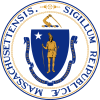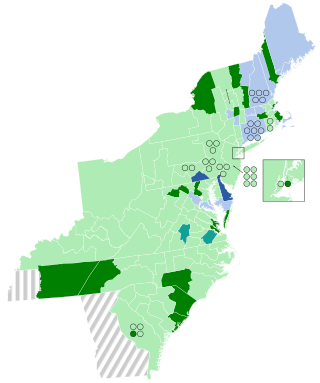A special election was held in Massachusetts's 12th congressional district on September 17, 1804, to fill a vacancy left by the resignation of Thomson J. Skinner (DR) on August 10, 1804 [1]
| Elections in Massachusetts |
|---|
 |
A special election was held in Massachusetts's 12th congressional district on September 17, 1804, to fill a vacancy left by the resignation of Thomson J. Skinner (DR) on August 10, 1804 [1]
| Candidate | Party | Votes [2] | Percent |
|---|---|---|---|
| Simon Larned | Democratic-Republican | 1,241 | 61.9% |
| Daniel Dewey | Federalist | 765 | 38.1% |
Larned took his seat on November 5, 1804, at the start of the 2nd session [3]

Massachusetts's 4th congressional district is located mostly in southern Massachusetts. It is represented by Democrat Jake Auchincloss. Auchincloss was first elected in 2020.

The 1804–05 United States House of Representatives elections were held on various dates in various states between April 24, 1804, and August 5, 1805. Each state set its own date for its elections to the House of Representatives before the first session of the 9th United States Congress convened on December 2, 1805. The elections occurred at the same time as President Thomas Jefferson's re-election. Elections were held for all 142 seats, representing 17 states.

A special election was held in New Jersey's at-large congressional district on January 11, 1795, to fill a vacancy in the Third Congress left by the death of Abraham Clark (P) on September 15, 1794.

A special election was held in New York's 1st congressional district April 24–26, 1804 to fill a vacancy left by the resignation of John Smith (DR) on February 22, 1804, after being elected to the Senate. The election was held at the same time as the elections for the 9th Congress and were combined into a single election, with the candidate receiving the most votes going to the 9th Congress and the candidate with the second most votes going to the 8th Congress.

A special election was held in Pennsylvania's 10th congressional district on November 2, 1804, to fill a vacancy left by the resignation of William Hoge (DR) on October 15, 1804.

A special election was held in Pennsylvania's 11th congressional district on October 8, 1805, to fill a vacancy left by the resignation of John B. Lucas (DR) before the first session of the 9th Congress to take a position as district judge for the District of Louisiana.

A special election was held in North Carolina's 5th congressional district on August 8, 1805 to fill a vacancy left by the death of Representative James Gillespie (DR) on January 5, 1805, before the 9th Congress began, but after the general elections had taken place for the 8th Congress.
A special election was held in South Carolina's 6th congressional district June 1–2, 1807 to fill a vacancy left by the death of Levi Casey (DR) on February 3, 1807.

A special election was held in Pennsylvania's 1st congressional district on October 10, 1809, to fill a vacancy left by the resignation of Representative Benjamin Say (DR) in June of that year.

A special election was held in Maryland's 7th congressional district to fill a vacancy left by the resignation of John Brown (DR) to accept a position as clerk of the county court of Queen Anne's County. Brown had earlier been re-elected to the 12th Congress, thus, his resignation created vacancies in both the 11th and 12th Congresses. Unusually, a single ballot was used for both vacancies. This was the first of at least three examples of this sort of dual-vacancy being filled with one ballot.

A special election was held in Pennsylvania's 3rd congressional district on October 11, 1814 to fill a vacancy caused by the resignation of James Whitehill (DR) on September 1, 1814. This was the second resignation from the 3rd district in the 13th congress, the previous resignation having been in the previous year.

Georgia's at-large congressional district special election, 1819 was called to fill a vacancy created when the former congressman was elected to the United States Senate.

A special election was held in North Carolina's 4th congressional district on August 4, 1795, to fill a vacancy left by the death of Alexander Mebane (DR) on July 5, 1795, before the start of the 1st session of the 4th Congress.

A special election was held in New Hampshire's at-large congressional district on August 30, 1802, to fill a vacancy left by the resignation of Joseph Peirce (F) earlier that year.
A special election was held in Massachusetts's 4th congressional district August 24, 1801 to fill a vacancy caused by the resignation of Levi Lincoln Sr. (DR) on March 5, 1801, before the first session of Congress, upon being appointed U.S. Attorney General.

A special election was held in North Carolina's 8th congressional district on August 6, 1801, to fill a vacancy created when David Stone (F) resigned upon being elected to the Senate before the 7th Congress began.

A special election was held in North Carolina's 8th congressional district on October 15, 1802, to fill a vacancy left by the death of Charles Johnson (DR) on July 23, 1802.
A special election was held in South Carolina's 4th congressional district on April 12–13, 1802 to fill a vacancy resulting from the resignation of Thomas Sumter (DR) on December 15, 1801, upon being elected to the Senate.

A special election was held in New Jersey's at-large congressional district October 10–11, 1814 to fill a vacancy left by the death of Jacob Hufty (F) on May 20, 1814.

A special election was held in North Carolina's 10th congressional district on August 2, 1798, to fill a vacancy left by the death of Nathan Bryan (DR) on June 4, 1798